Recommendations for Upgrading Emergency Services in Canada
VerifiedAdded on 2023/06/14
|11
|2165
|339
AI Summary
This report evaluates essential recommendations for Premier and the Ministry of Health to upgrade Emergency services in Canada. It includes individual proposed operational structures with current conditions of the service and recommendations for improvement.
Contribute Materials
Your contribution can guide someone’s learning journey. Share your
documents today.
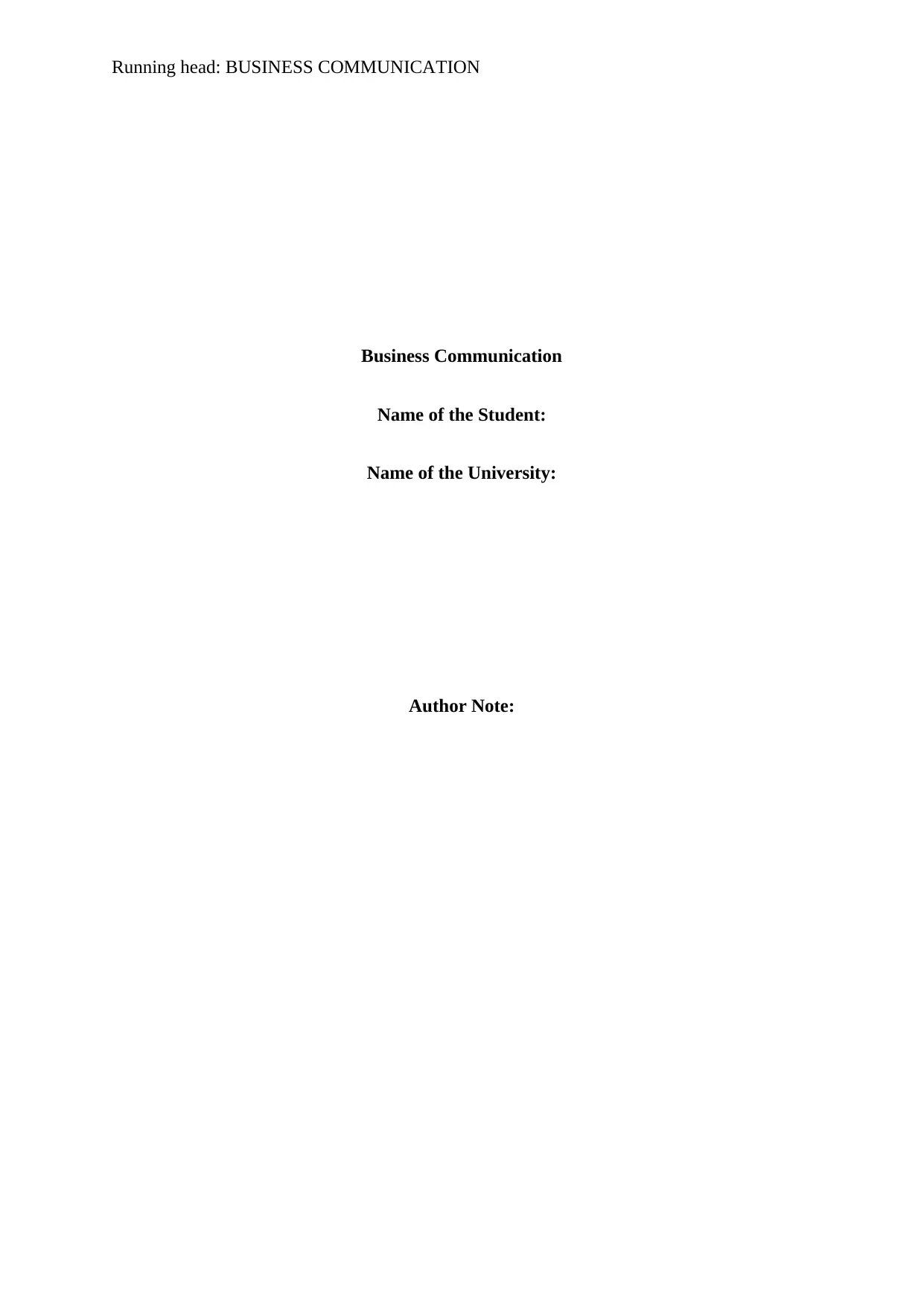
Running head: BUSINESS COMMUNICATION
Business Communication
Name of the Student:
Name of the University:
Author Note:
Business Communication
Name of the Student:
Name of the University:
Author Note:
Secure Best Marks with AI Grader
Need help grading? Try our AI Grader for instant feedback on your assignments.
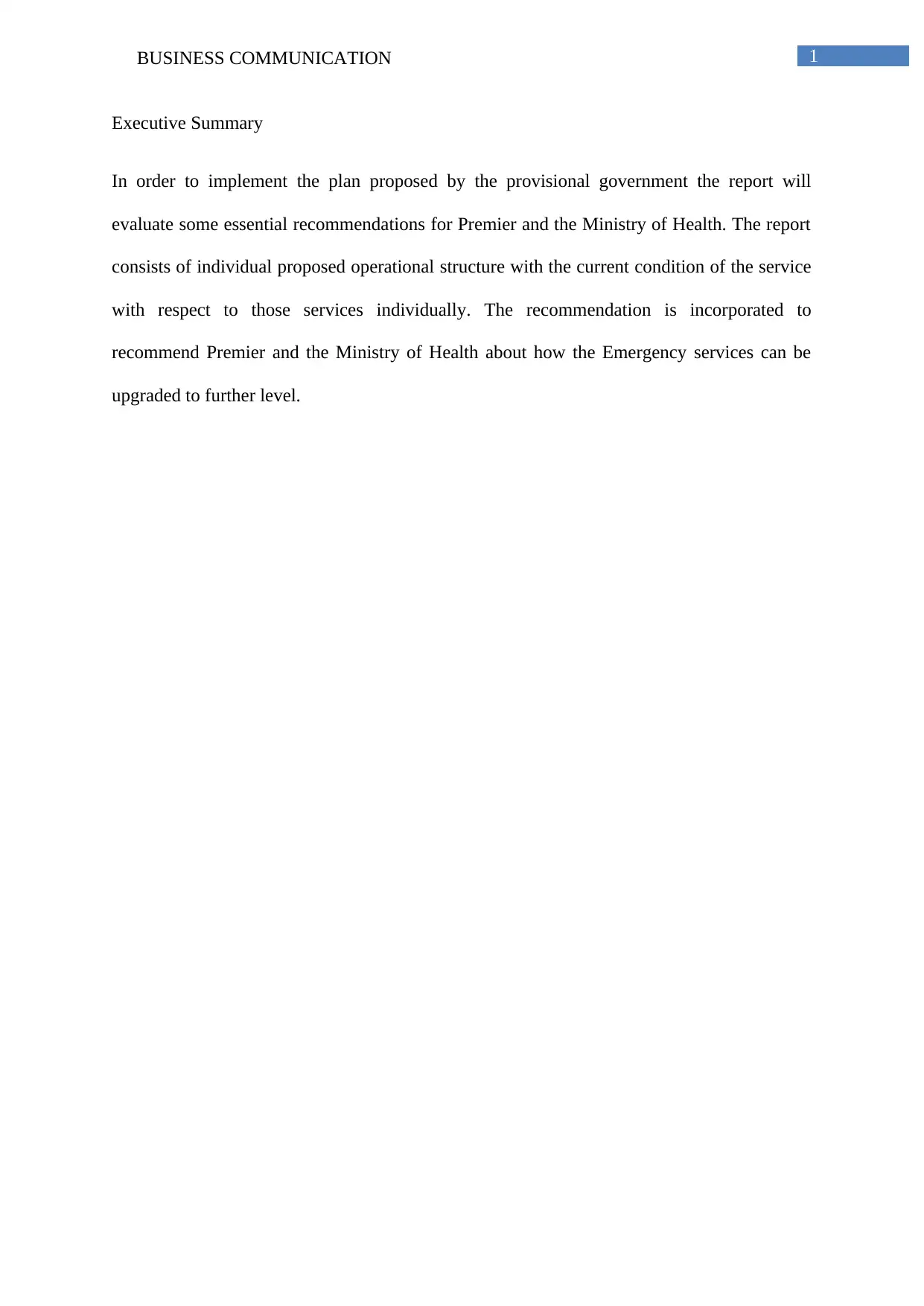
1BUSINESS COMMUNICATION
Executive Summary
In order to implement the plan proposed by the provisional government the report will
evaluate some essential recommendations for Premier and the Ministry of Health. The report
consists of individual proposed operational structure with the current condition of the service
with respect to those services individually. The recommendation is incorporated to
recommend Premier and the Ministry of Health about how the Emergency services can be
upgraded to further level.
Executive Summary
In order to implement the plan proposed by the provisional government the report will
evaluate some essential recommendations for Premier and the Ministry of Health. The report
consists of individual proposed operational structure with the current condition of the service
with respect to those services individually. The recommendation is incorporated to
recommend Premier and the Ministry of Health about how the Emergency services can be
upgraded to further level.
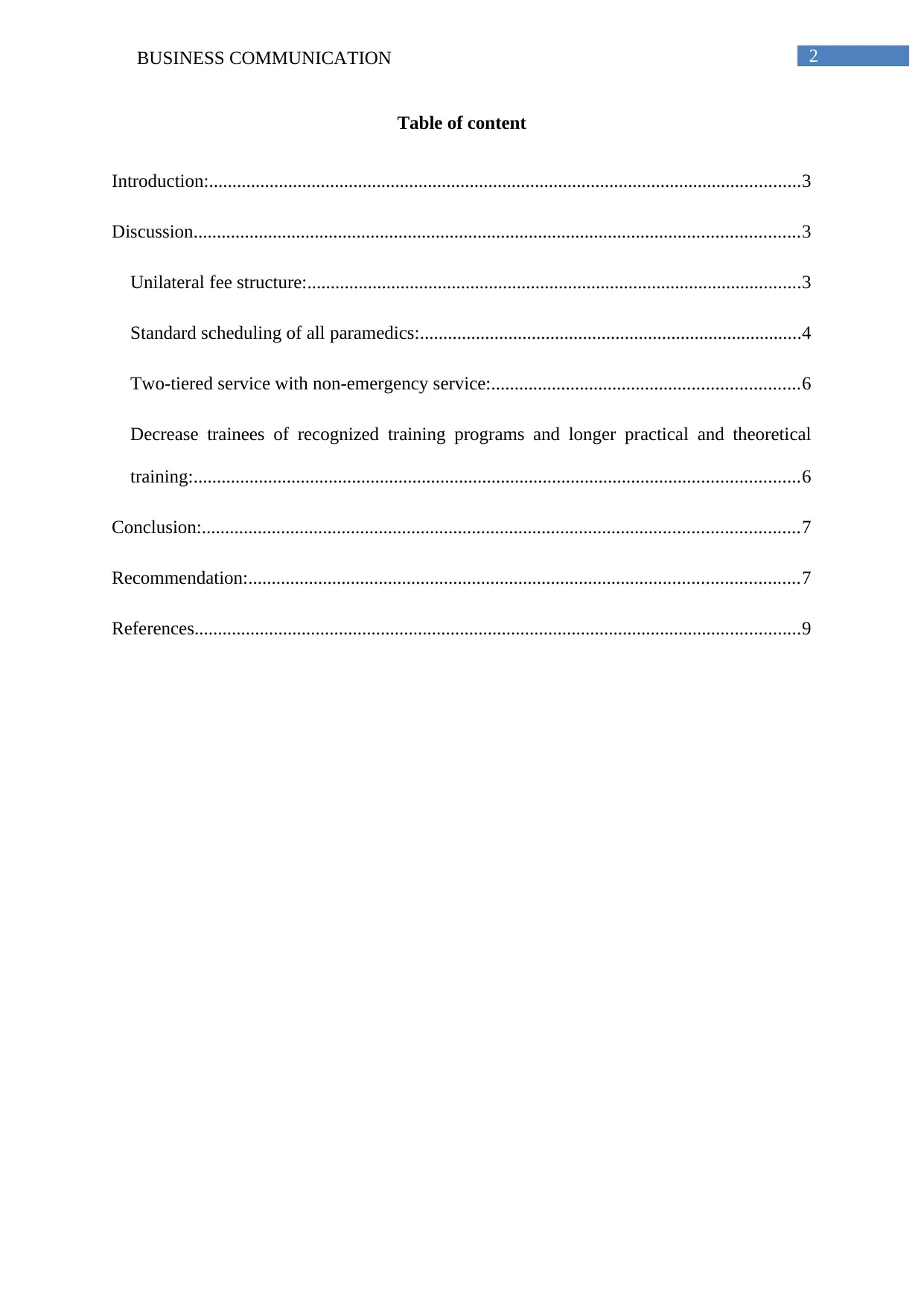
2BUSINESS COMMUNICATION
Table of content
Introduction:...............................................................................................................................3
Discussion..................................................................................................................................3
Unilateral fee structure:..........................................................................................................3
Standard scheduling of all paramedics:..................................................................................4
Two-tiered service with non-emergency service:..................................................................6
Decrease trainees of recognized training programs and longer practical and theoretical
training:..................................................................................................................................6
Conclusion:................................................................................................................................7
Recommendation:......................................................................................................................7
References..................................................................................................................................9
Table of content
Introduction:...............................................................................................................................3
Discussion..................................................................................................................................3
Unilateral fee structure:..........................................................................................................3
Standard scheduling of all paramedics:..................................................................................4
Two-tiered service with non-emergency service:..................................................................6
Decrease trainees of recognized training programs and longer practical and theoretical
training:..................................................................................................................................6
Conclusion:................................................................................................................................7
Recommendation:......................................................................................................................7
References..................................................................................................................................9
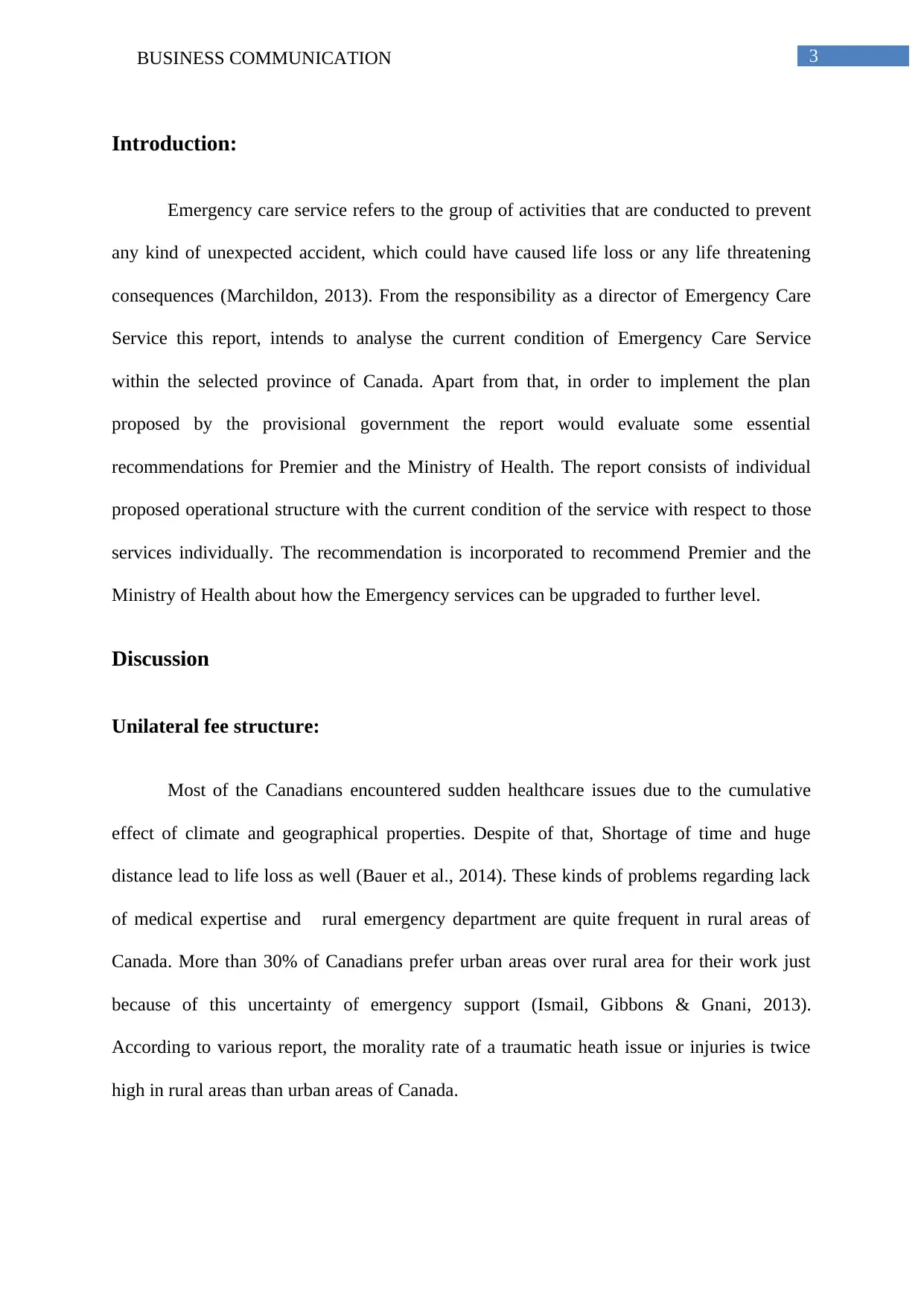
3BUSINESS COMMUNICATION
Introduction:
Emergency care service refers to the group of activities that are conducted to prevent
any kind of unexpected accident, which could have caused life loss or any life threatening
consequences (Marchildon, 2013). From the responsibility as a director of Emergency Care
Service this report, intends to analyse the current condition of Emergency Care Service
within the selected province of Canada. Apart from that, in order to implement the plan
proposed by the provisional government the report would evaluate some essential
recommendations for Premier and the Ministry of Health. The report consists of individual
proposed operational structure with the current condition of the service with respect to those
services individually. The recommendation is incorporated to recommend Premier and the
Ministry of Health about how the Emergency services can be upgraded to further level.
Discussion
Unilateral fee structure:
Most of the Canadians encountered sudden healthcare issues due to the cumulative
effect of climate and geographical properties. Despite of that, Shortage of time and huge
distance lead to life loss as well (Bauer et al., 2014). These kinds of problems regarding lack
of medical expertise and rural emergency department are quite frequent in rural areas of
Canada. More than 30% of Canadians prefer urban areas over rural area for their work just
because of this uncertainty of emergency support (Ismail, Gibbons & Gnani, 2013).
According to various report, the morality rate of a traumatic heath issue or injuries is twice
high in rural areas than urban areas of Canada.
Introduction:
Emergency care service refers to the group of activities that are conducted to prevent
any kind of unexpected accident, which could have caused life loss or any life threatening
consequences (Marchildon, 2013). From the responsibility as a director of Emergency Care
Service this report, intends to analyse the current condition of Emergency Care Service
within the selected province of Canada. Apart from that, in order to implement the plan
proposed by the provisional government the report would evaluate some essential
recommendations for Premier and the Ministry of Health. The report consists of individual
proposed operational structure with the current condition of the service with respect to those
services individually. The recommendation is incorporated to recommend Premier and the
Ministry of Health about how the Emergency services can be upgraded to further level.
Discussion
Unilateral fee structure:
Most of the Canadians encountered sudden healthcare issues due to the cumulative
effect of climate and geographical properties. Despite of that, Shortage of time and huge
distance lead to life loss as well (Bauer et al., 2014). These kinds of problems regarding lack
of medical expertise and rural emergency department are quite frequent in rural areas of
Canada. More than 30% of Canadians prefer urban areas over rural area for their work just
because of this uncertainty of emergency support (Ismail, Gibbons & Gnani, 2013).
According to various report, the morality rate of a traumatic heath issue or injuries is twice
high in rural areas than urban areas of Canada.
Secure Best Marks with AI Grader
Need help grading? Try our AI Grader for instant feedback on your assignments.
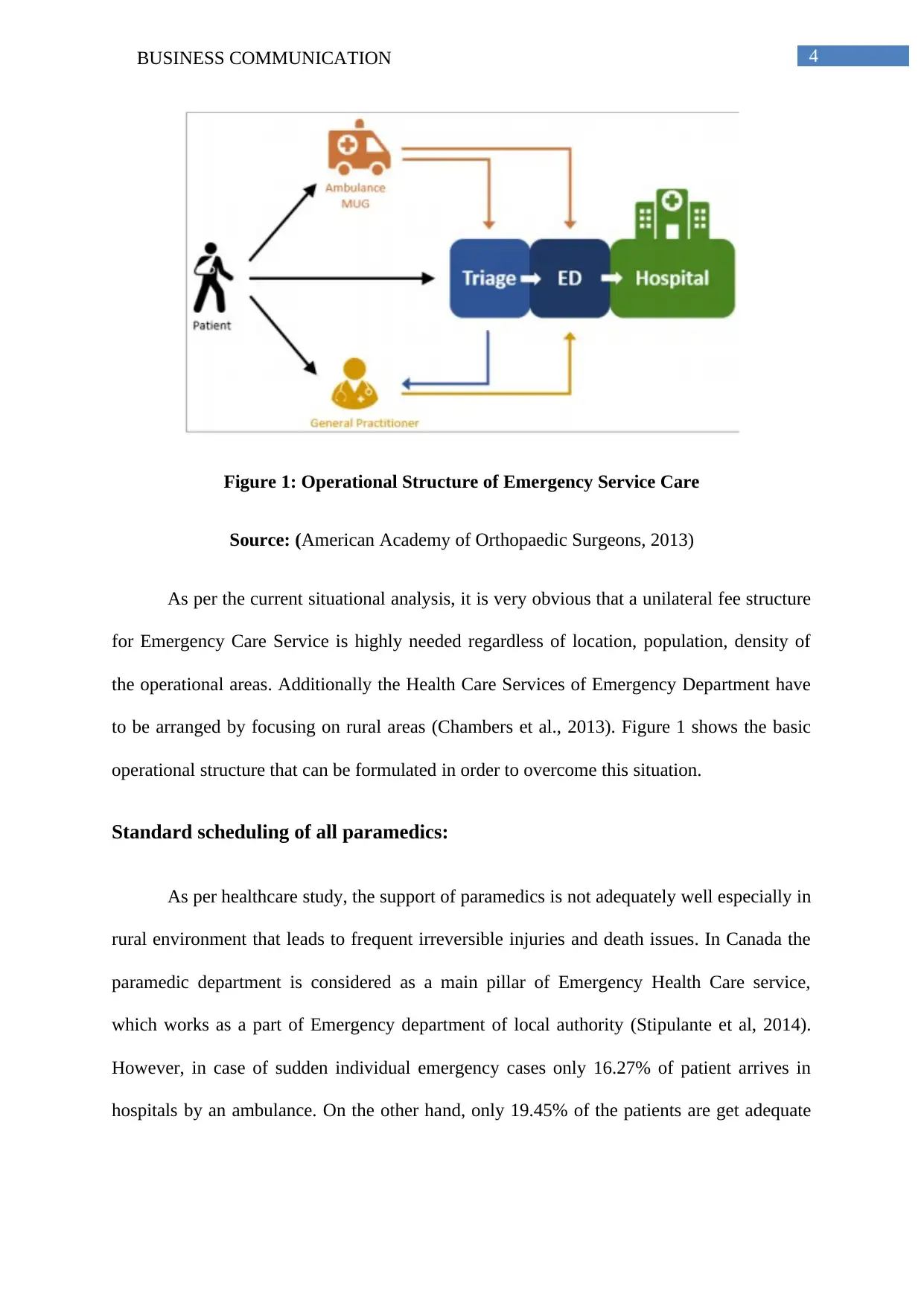
4BUSINESS COMMUNICATION
Figure 1: Operational Structure of Emergency Service Care
Source: (American Academy of Orthopaedic Surgeons, 2013)
As per the current situational analysis, it is very obvious that a unilateral fee structure
for Emergency Care Service is highly needed regardless of location, population, density of
the operational areas. Additionally the Health Care Services of Emergency Department have
to be arranged by focusing on rural areas (Chambers et al., 2013). Figure 1 shows the basic
operational structure that can be formulated in order to overcome this situation.
Standard scheduling of all paramedics:
As per healthcare study, the support of paramedics is not adequately well especially in
rural environment that leads to frequent irreversible injuries and death issues. In Canada the
paramedic department is considered as a main pillar of Emergency Health Care service,
which works as a part of Emergency department of local authority (Stipulante et al, 2014).
However, in case of sudden individual emergency cases only 16.27% of patient arrives in
hospitals by an ambulance. On the other hand, only 19.45% of the patients are get adequate
Figure 1: Operational Structure of Emergency Service Care
Source: (American Academy of Orthopaedic Surgeons, 2013)
As per the current situational analysis, it is very obvious that a unilateral fee structure
for Emergency Care Service is highly needed regardless of location, population, density of
the operational areas. Additionally the Health Care Services of Emergency Department have
to be arranged by focusing on rural areas (Chambers et al., 2013). Figure 1 shows the basic
operational structure that can be formulated in order to overcome this situation.
Standard scheduling of all paramedics:
As per healthcare study, the support of paramedics is not adequately well especially in
rural environment that leads to frequent irreversible injuries and death issues. In Canada the
paramedic department is considered as a main pillar of Emergency Health Care service,
which works as a part of Emergency department of local authority (Stipulante et al, 2014).
However, in case of sudden individual emergency cases only 16.27% of patient arrives in
hospitals by an ambulance. On the other hand, only 19.45% of the patients are get adequate
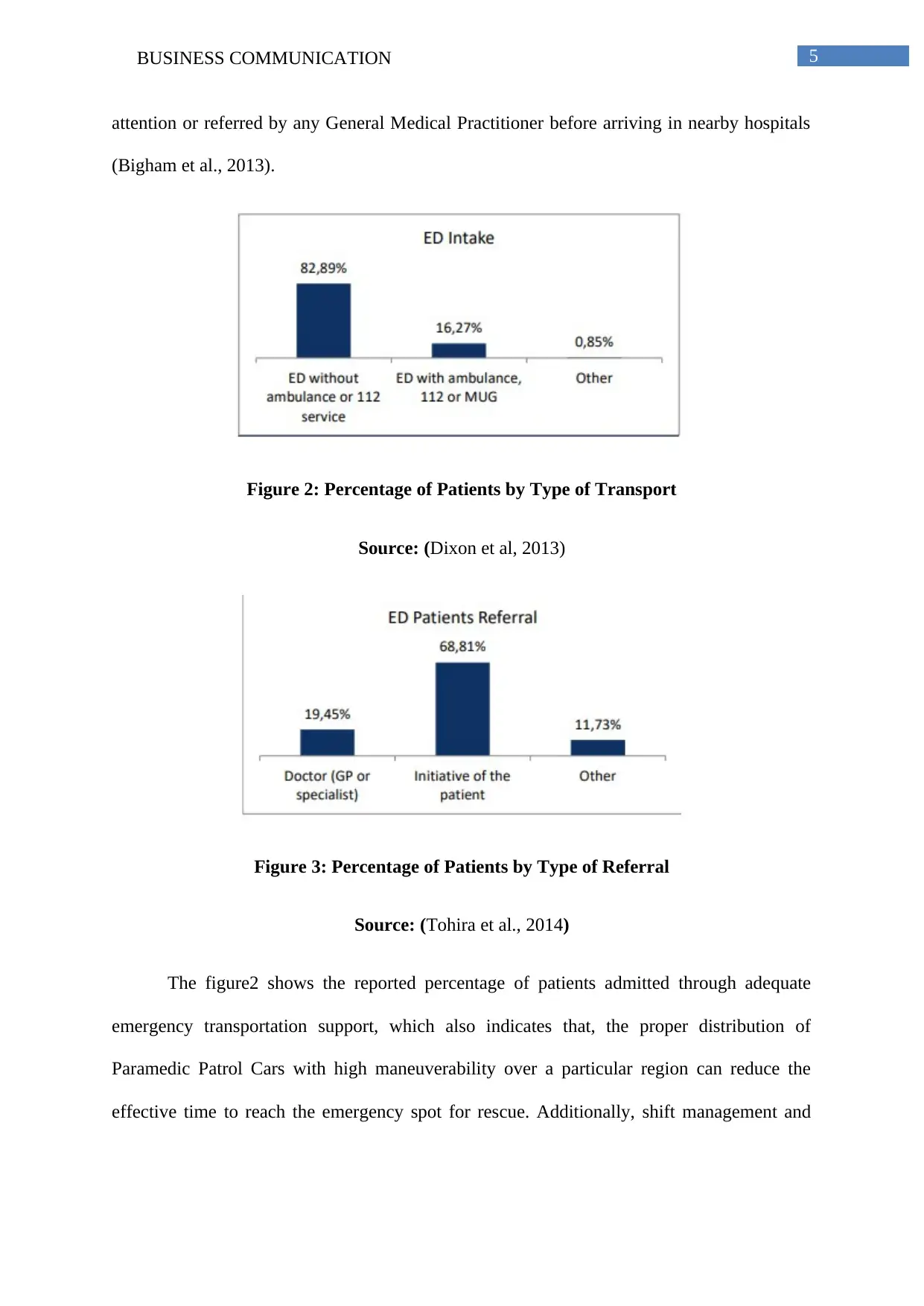
5BUSINESS COMMUNICATION
attention or referred by any General Medical Practitioner before arriving in nearby hospitals
(Bigham et al., 2013).
Figure 2: Percentage of Patients by Type of Transport
Source: (Dixon et al, 2013)
Figure 3: Percentage of Patients by Type of Referral
Source: (Tohira et al., 2014)
The figure2 shows the reported percentage of patients admitted through adequate
emergency transportation support, which also indicates that, the proper distribution of
Paramedic Patrol Cars with high maneuverability over a particular region can reduce the
effective time to reach the emergency spot for rescue. Additionally, shift management and
attention or referred by any General Medical Practitioner before arriving in nearby hospitals
(Bigham et al., 2013).
Figure 2: Percentage of Patients by Type of Transport
Source: (Dixon et al, 2013)
Figure 3: Percentage of Patients by Type of Referral
Source: (Tohira et al., 2014)
The figure2 shows the reported percentage of patients admitted through adequate
emergency transportation support, which also indicates that, the proper distribution of
Paramedic Patrol Cars with high maneuverability over a particular region can reduce the
effective time to reach the emergency spot for rescue. Additionally, shift management and
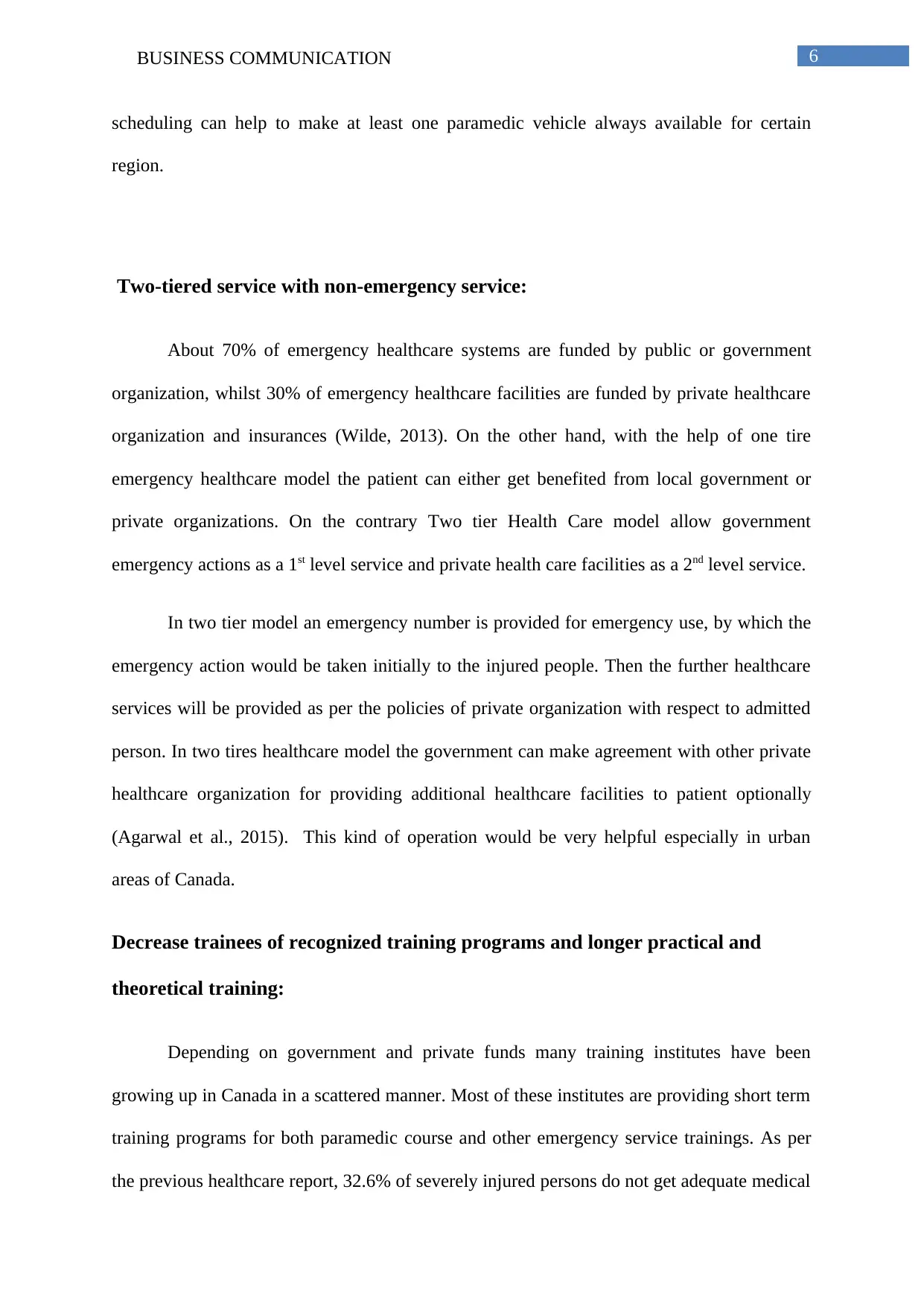
6BUSINESS COMMUNICATION
scheduling can help to make at least one paramedic vehicle always available for certain
region.
Two-tiered service with non-emergency service:
About 70% of emergency healthcare systems are funded by public or government
organization, whilst 30% of emergency healthcare facilities are funded by private healthcare
organization and insurances (Wilde, 2013). On the other hand, with the help of one tire
emergency healthcare model the patient can either get benefited from local government or
private organizations. On the contrary Two tier Health Care model allow government
emergency actions as a 1st level service and private health care facilities as a 2nd level service.
In two tier model an emergency number is provided for emergency use, by which the
emergency action would be taken initially to the injured people. Then the further healthcare
services will be provided as per the policies of private organization with respect to admitted
person. In two tires healthcare model the government can make agreement with other private
healthcare organization for providing additional healthcare facilities to patient optionally
(Agarwal et al., 2015). This kind of operation would be very helpful especially in urban
areas of Canada.
Decrease trainees of recognized training programs and longer practical and
theoretical training:
Depending on government and private funds many training institutes have been
growing up in Canada in a scattered manner. Most of these institutes are providing short term
training programs for both paramedic course and other emergency service trainings. As per
the previous healthcare report, 32.6% of severely injured persons do not get adequate medical
scheduling can help to make at least one paramedic vehicle always available for certain
region.
Two-tiered service with non-emergency service:
About 70% of emergency healthcare systems are funded by public or government
organization, whilst 30% of emergency healthcare facilities are funded by private healthcare
organization and insurances (Wilde, 2013). On the other hand, with the help of one tire
emergency healthcare model the patient can either get benefited from local government or
private organizations. On the contrary Two tier Health Care model allow government
emergency actions as a 1st level service and private health care facilities as a 2nd level service.
In two tier model an emergency number is provided for emergency use, by which the
emergency action would be taken initially to the injured people. Then the further healthcare
services will be provided as per the policies of private organization with respect to admitted
person. In two tires healthcare model the government can make agreement with other private
healthcare organization for providing additional healthcare facilities to patient optionally
(Agarwal et al., 2015). This kind of operation would be very helpful especially in urban
areas of Canada.
Decrease trainees of recognized training programs and longer practical and
theoretical training:
Depending on government and private funds many training institutes have been
growing up in Canada in a scattered manner. Most of these institutes are providing short term
training programs for both paramedic course and other emergency service trainings. As per
the previous healthcare report, 32.6% of severely injured persons do not get adequate medical
Paraphrase This Document
Need a fresh take? Get an instant paraphrase of this document with our AI Paraphraser
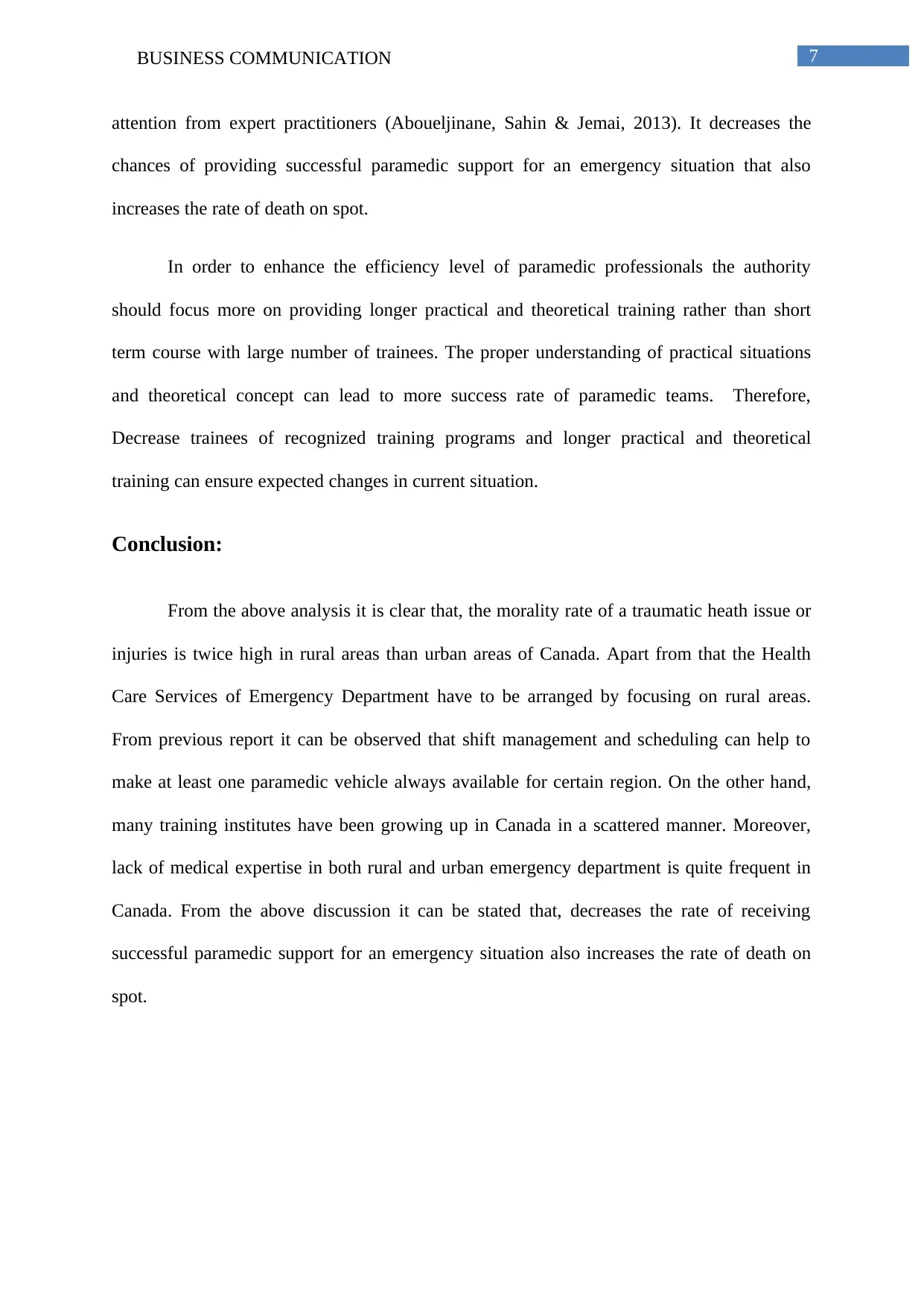
7BUSINESS COMMUNICATION
attention from expert practitioners (Aboueljinane, Sahin & Jemai, 2013). It decreases the
chances of providing successful paramedic support for an emergency situation that also
increases the rate of death on spot.
In order to enhance the efficiency level of paramedic professionals the authority
should focus more on providing longer practical and theoretical training rather than short
term course with large number of trainees. The proper understanding of practical situations
and theoretical concept can lead to more success rate of paramedic teams. Therefore,
Decrease trainees of recognized training programs and longer practical and theoretical
training can ensure expected changes in current situation.
Conclusion:
From the above analysis it is clear that, the morality rate of a traumatic heath issue or
injuries is twice high in rural areas than urban areas of Canada. Apart from that the Health
Care Services of Emergency Department have to be arranged by focusing on rural areas.
From previous report it can be observed that shift management and scheduling can help to
make at least one paramedic vehicle always available for certain region. On the other hand,
many training institutes have been growing up in Canada in a scattered manner. Moreover,
lack of medical expertise in both rural and urban emergency department is quite frequent in
Canada. From the above discussion it can be stated that, decreases the rate of receiving
successful paramedic support for an emergency situation also increases the rate of death on
spot.
attention from expert practitioners (Aboueljinane, Sahin & Jemai, 2013). It decreases the
chances of providing successful paramedic support for an emergency situation that also
increases the rate of death on spot.
In order to enhance the efficiency level of paramedic professionals the authority
should focus more on providing longer practical and theoretical training rather than short
term course with large number of trainees. The proper understanding of practical situations
and theoretical concept can lead to more success rate of paramedic teams. Therefore,
Decrease trainees of recognized training programs and longer practical and theoretical
training can ensure expected changes in current situation.
Conclusion:
From the above analysis it is clear that, the morality rate of a traumatic heath issue or
injuries is twice high in rural areas than urban areas of Canada. Apart from that the Health
Care Services of Emergency Department have to be arranged by focusing on rural areas.
From previous report it can be observed that shift management and scheduling can help to
make at least one paramedic vehicle always available for certain region. On the other hand,
many training institutes have been growing up in Canada in a scattered manner. Moreover,
lack of medical expertise in both rural and urban emergency department is quite frequent in
Canada. From the above discussion it can be stated that, decreases the rate of receiving
successful paramedic support for an emergency situation also increases the rate of death on
spot.
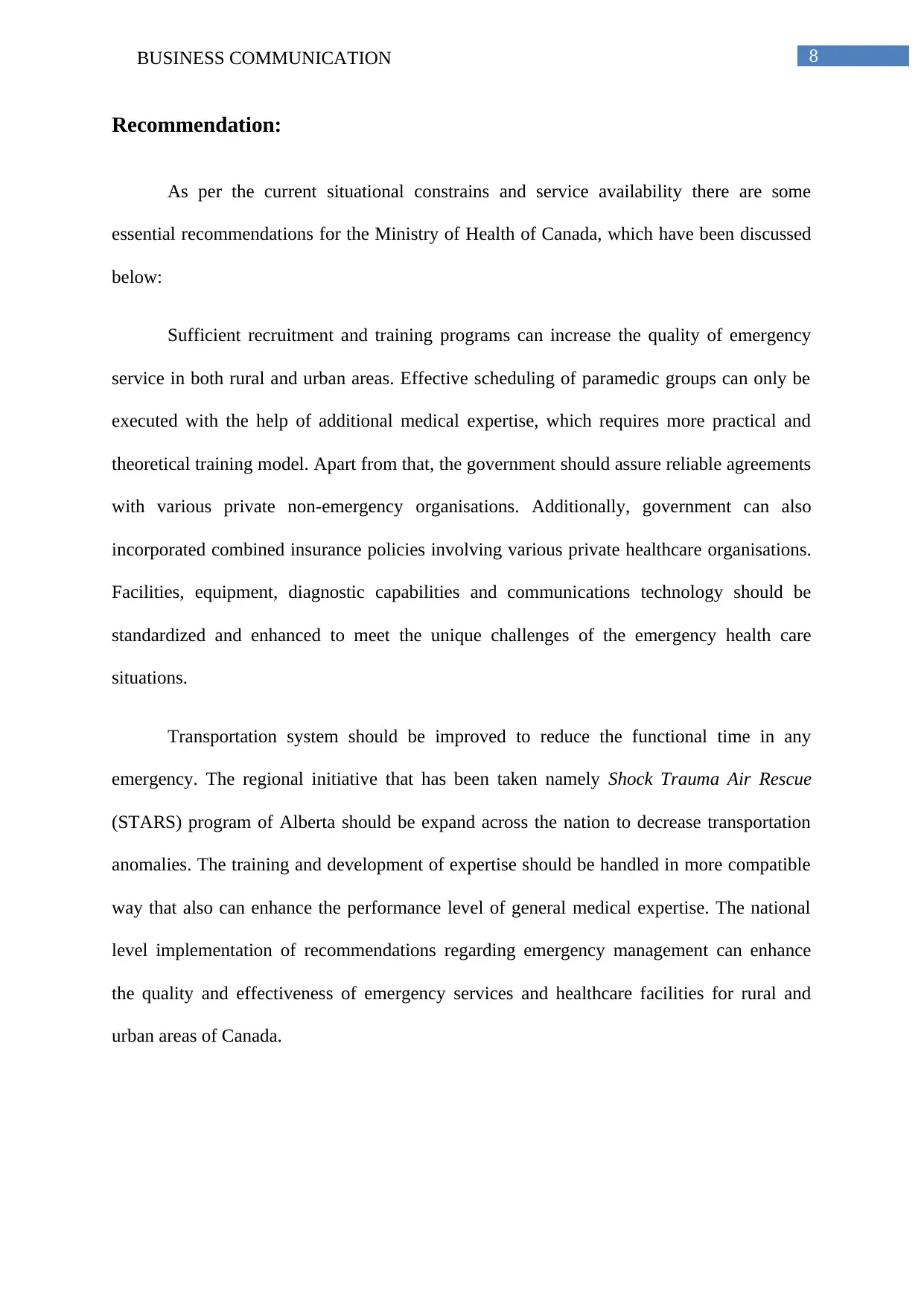
8BUSINESS COMMUNICATION
Recommendation:
As per the current situational constrains and service availability there are some
essential recommendations for the Ministry of Health of Canada, which have been discussed
below:
Sufficient recruitment and training programs can increase the quality of emergency
service in both rural and urban areas. Effective scheduling of paramedic groups can only be
executed with the help of additional medical expertise, which requires more practical and
theoretical training model. Apart from that, the government should assure reliable agreements
with various private non-emergency organisations. Additionally, government can also
incorporated combined insurance policies involving various private healthcare organisations.
Facilities, equipment, diagnostic capabilities and communications technology should be
standardized and enhanced to meet the unique challenges of the emergency health care
situations.
Transportation system should be improved to reduce the functional time in any
emergency. The regional initiative that has been taken namely Shock Trauma Air Rescue
(STARS) program of Alberta should be expand across the nation to decrease transportation
anomalies. The training and development of expertise should be handled in more compatible
way that also can enhance the performance level of general medical expertise. The national
level implementation of recommendations regarding emergency management can enhance
the quality and effectiveness of emergency services and healthcare facilities for rural and
urban areas of Canada.
Recommendation:
As per the current situational constrains and service availability there are some
essential recommendations for the Ministry of Health of Canada, which have been discussed
below:
Sufficient recruitment and training programs can increase the quality of emergency
service in both rural and urban areas. Effective scheduling of paramedic groups can only be
executed with the help of additional medical expertise, which requires more practical and
theoretical training model. Apart from that, the government should assure reliable agreements
with various private non-emergency organisations. Additionally, government can also
incorporated combined insurance policies involving various private healthcare organisations.
Facilities, equipment, diagnostic capabilities and communications technology should be
standardized and enhanced to meet the unique challenges of the emergency health care
situations.
Transportation system should be improved to reduce the functional time in any
emergency. The regional initiative that has been taken namely Shock Trauma Air Rescue
(STARS) program of Alberta should be expand across the nation to decrease transportation
anomalies. The training and development of expertise should be handled in more compatible
way that also can enhance the performance level of general medical expertise. The national
level implementation of recommendations regarding emergency management can enhance
the quality and effectiveness of emergency services and healthcare facilities for rural and
urban areas of Canada.
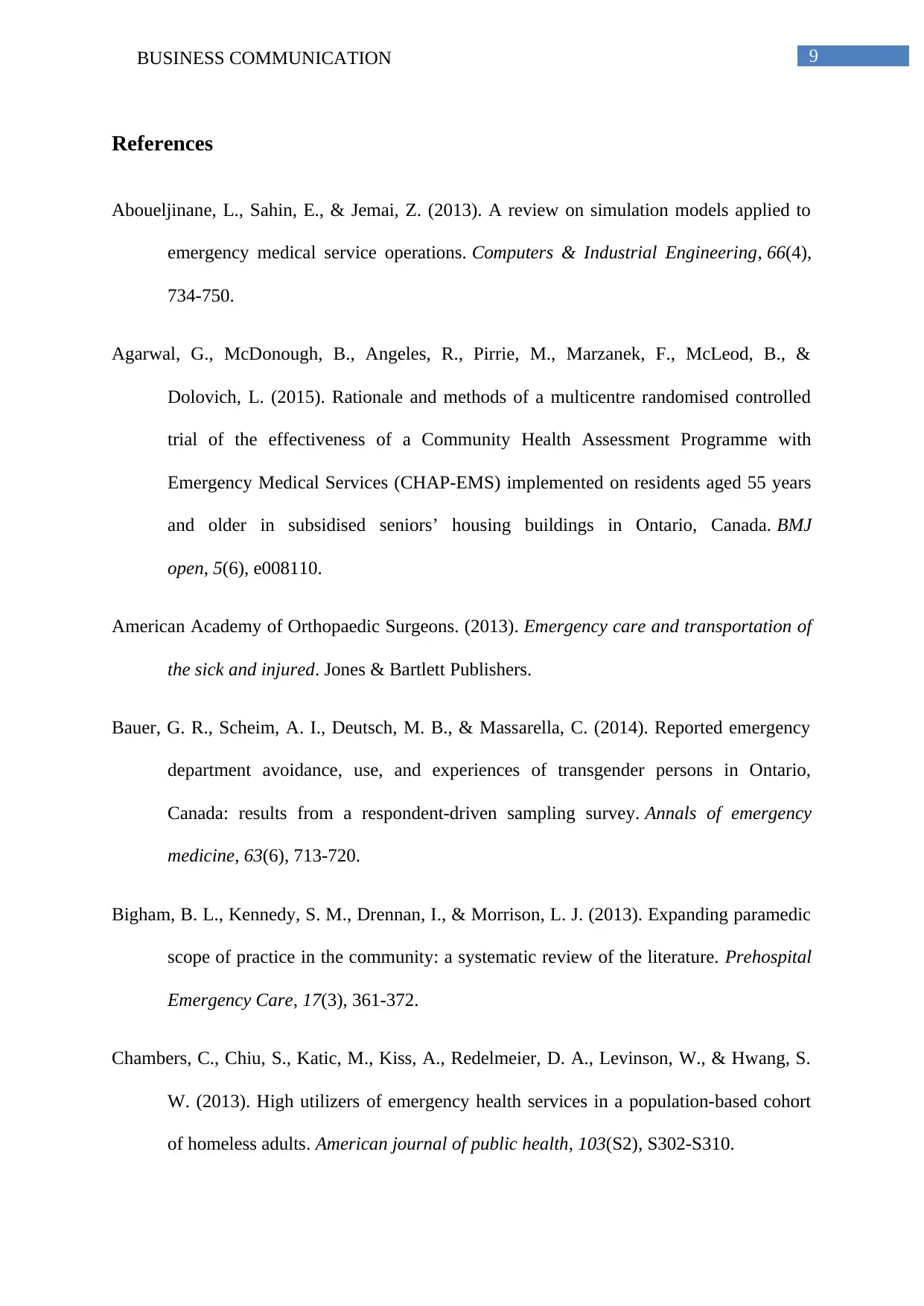
9BUSINESS COMMUNICATION
References
Aboueljinane, L., Sahin, E., & Jemai, Z. (2013). A review on simulation models applied to
emergency medical service operations. Computers & Industrial Engineering, 66(4),
734-750.
Agarwal, G., McDonough, B., Angeles, R., Pirrie, M., Marzanek, F., McLeod, B., &
Dolovich, L. (2015). Rationale and methods of a multicentre randomised controlled
trial of the effectiveness of a Community Health Assessment Programme with
Emergency Medical Services (CHAP-EMS) implemented on residents aged 55 years
and older in subsidised seniors’ housing buildings in Ontario, Canada. BMJ
open, 5(6), e008110.
American Academy of Orthopaedic Surgeons. (2013). Emergency care and transportation of
the sick and injured. Jones & Bartlett Publishers.
Bauer, G. R., Scheim, A. I., Deutsch, M. B., & Massarella, C. (2014). Reported emergency
department avoidance, use, and experiences of transgender persons in Ontario,
Canada: results from a respondent-driven sampling survey. Annals of emergency
medicine, 63(6), 713-720.
Bigham, B. L., Kennedy, S. M., Drennan, I., & Morrison, L. J. (2013). Expanding paramedic
scope of practice in the community: a systematic review of the literature. Prehospital
Emergency Care, 17(3), 361-372.
Chambers, C., Chiu, S., Katic, M., Kiss, A., Redelmeier, D. A., Levinson, W., & Hwang, S.
W. (2013). High utilizers of emergency health services in a population-based cohort
of homeless adults. American journal of public health, 103(S2), S302-S310.
References
Aboueljinane, L., Sahin, E., & Jemai, Z. (2013). A review on simulation models applied to
emergency medical service operations. Computers & Industrial Engineering, 66(4),
734-750.
Agarwal, G., McDonough, B., Angeles, R., Pirrie, M., Marzanek, F., McLeod, B., &
Dolovich, L. (2015). Rationale and methods of a multicentre randomised controlled
trial of the effectiveness of a Community Health Assessment Programme with
Emergency Medical Services (CHAP-EMS) implemented on residents aged 55 years
and older in subsidised seniors’ housing buildings in Ontario, Canada. BMJ
open, 5(6), e008110.
American Academy of Orthopaedic Surgeons. (2013). Emergency care and transportation of
the sick and injured. Jones & Bartlett Publishers.
Bauer, G. R., Scheim, A. I., Deutsch, M. B., & Massarella, C. (2014). Reported emergency
department avoidance, use, and experiences of transgender persons in Ontario,
Canada: results from a respondent-driven sampling survey. Annals of emergency
medicine, 63(6), 713-720.
Bigham, B. L., Kennedy, S. M., Drennan, I., & Morrison, L. J. (2013). Expanding paramedic
scope of practice in the community: a systematic review of the literature. Prehospital
Emergency Care, 17(3), 361-372.
Chambers, C., Chiu, S., Katic, M., Kiss, A., Redelmeier, D. A., Levinson, W., & Hwang, S.
W. (2013). High utilizers of emergency health services in a population-based cohort
of homeless adults. American journal of public health, 103(S2), S302-S310.
Secure Best Marks with AI Grader
Need help grading? Try our AI Grader for instant feedback on your assignments.
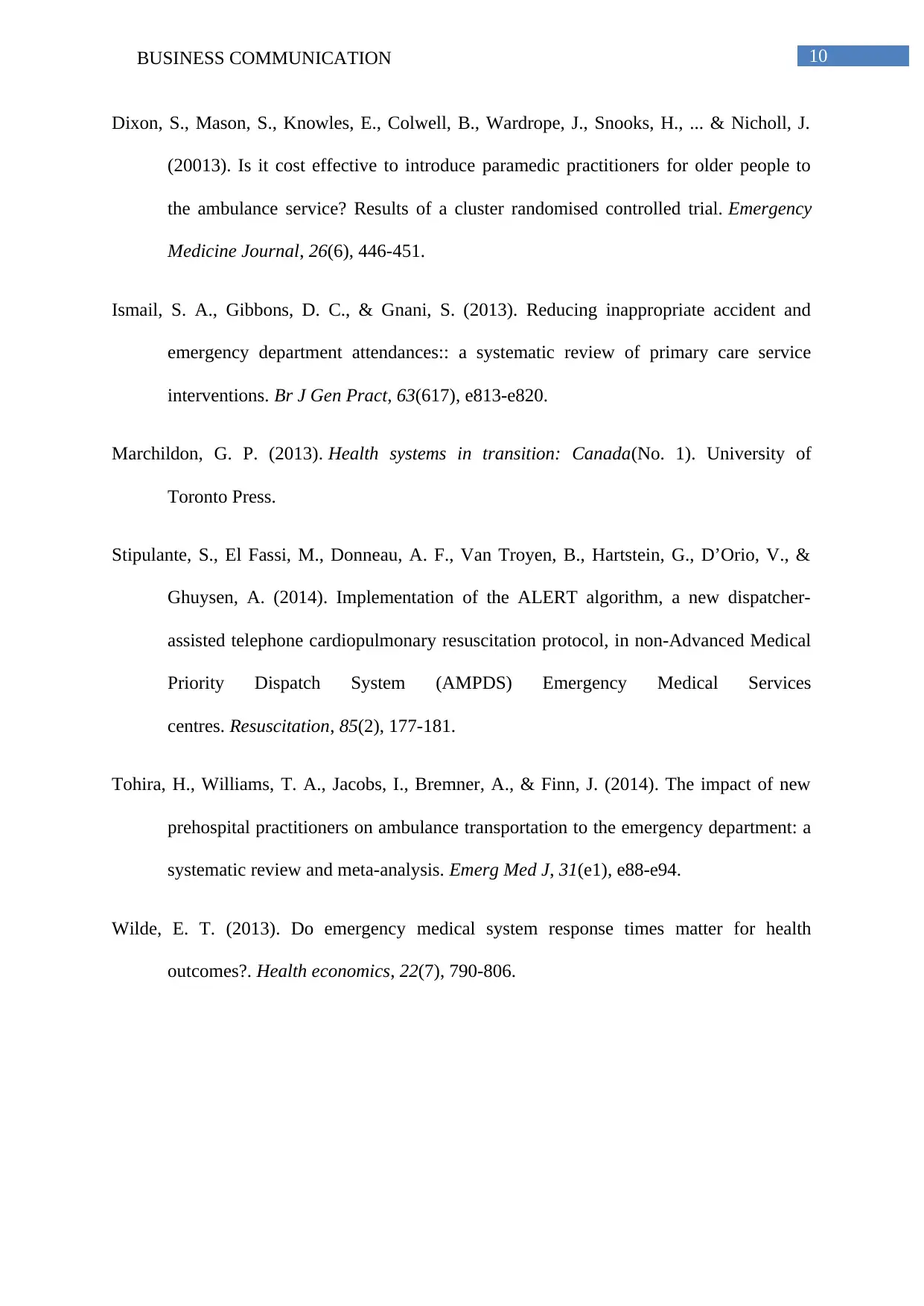
10BUSINESS COMMUNICATION
Dixon, S., Mason, S., Knowles, E., Colwell, B., Wardrope, J., Snooks, H., ... & Nicholl, J.
(20013). Is it cost effective to introduce paramedic practitioners for older people to
the ambulance service? Results of a cluster randomised controlled trial. Emergency
Medicine Journal, 26(6), 446-451.
Ismail, S. A., Gibbons, D. C., & Gnani, S. (2013). Reducing inappropriate accident and
emergency department attendances:: a systematic review of primary care service
interventions. Br J Gen Pract, 63(617), e813-e820.
Marchildon, G. P. (2013). Health systems in transition: Canada(No. 1). University of
Toronto Press.
Stipulante, S., El Fassi, M., Donneau, A. F., Van Troyen, B., Hartstein, G., D’Orio, V., &
Ghuysen, A. (2014). Implementation of the ALERT algorithm, a new dispatcher-
assisted telephone cardiopulmonary resuscitation protocol, in non-Advanced Medical
Priority Dispatch System (AMPDS) Emergency Medical Services
centres. Resuscitation, 85(2), 177-181.
Tohira, H., Williams, T. A., Jacobs, I., Bremner, A., & Finn, J. (2014). The impact of new
prehospital practitioners on ambulance transportation to the emergency department: a
systematic review and meta-analysis. Emerg Med J, 31(e1), e88-e94.
Wilde, E. T. (2013). Do emergency medical system response times matter for health
outcomes?. Health economics, 22(7), 790-806.
Dixon, S., Mason, S., Knowles, E., Colwell, B., Wardrope, J., Snooks, H., ... & Nicholl, J.
(20013). Is it cost effective to introduce paramedic practitioners for older people to
the ambulance service? Results of a cluster randomised controlled trial. Emergency
Medicine Journal, 26(6), 446-451.
Ismail, S. A., Gibbons, D. C., & Gnani, S. (2013). Reducing inappropriate accident and
emergency department attendances:: a systematic review of primary care service
interventions. Br J Gen Pract, 63(617), e813-e820.
Marchildon, G. P. (2013). Health systems in transition: Canada(No. 1). University of
Toronto Press.
Stipulante, S., El Fassi, M., Donneau, A. F., Van Troyen, B., Hartstein, G., D’Orio, V., &
Ghuysen, A. (2014). Implementation of the ALERT algorithm, a new dispatcher-
assisted telephone cardiopulmonary resuscitation protocol, in non-Advanced Medical
Priority Dispatch System (AMPDS) Emergency Medical Services
centres. Resuscitation, 85(2), 177-181.
Tohira, H., Williams, T. A., Jacobs, I., Bremner, A., & Finn, J. (2014). The impact of new
prehospital practitioners on ambulance transportation to the emergency department: a
systematic review and meta-analysis. Emerg Med J, 31(e1), e88-e94.
Wilde, E. T. (2013). Do emergency medical system response times matter for health
outcomes?. Health economics, 22(7), 790-806.
1 out of 11
Related Documents
Your All-in-One AI-Powered Toolkit for Academic Success.
+13062052269
info@desklib.com
Available 24*7 on WhatsApp / Email
![[object Object]](/_next/static/media/star-bottom.7253800d.svg)
Unlock your academic potential
© 2024 | Zucol Services PVT LTD | All rights reserved.




